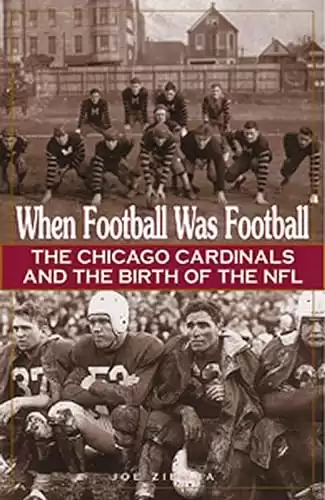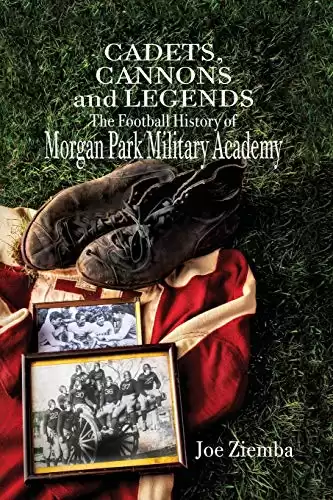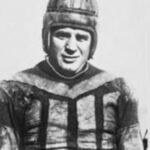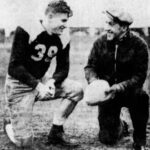When we think of really big men who have had a positive impact on the National Football League, some familiar names readily come to mind, such as Ed “Too Tall” Jones, William “The Refrigerator” Perry, Gene “Big Daddy” Lipscomb, and many others.
But here in Chicago, a gentleman who was not nearly as large as some of the aforementioned athletes provided a massive contribution to the NFL and may have even saved it! Hugh Light “Shorty” Ray was only 5-5 and 135 pounds, but his dedication, innovation, and persistence helped ease the league into a new era at a time when professional football was still looked upon as the poor stepchild of the collegiate version.
Shorty Ray obviously did not pursue his livelihood on the field and carefully avoided confrontations with massive defensive ends. Rather, Shorty did his damage with slide rulers, a stopwatch, and an ample supply of common sense.
In fact, George Halas, owner of the Chicago Bears, and one of the founders of the NFL claimed that Shorty Ray was one of the most significant contributors to the growth of the league and one who was hired on the recommendation of Halas. In his autobiography, Halas proudly stated: “In 1937, I persuaded the league to hire Shorty as a full-time technical consultant. It was one of my finest contributions!”
Who Was Shorty Ray?
But who was Shorty Ray and why is he a member today of the Pro Football Hall of Fame? To answer that question, let’s take a peek into the distant gridiron past on this episode of “When Football Was Football” here on the Sports History Network…
Shorty Ray was born in Highland Park, Illinois (a northern suburb of Chicago) in 1884 but attended Crane Manual High School in Chicago a few years before George Halas himself graduated from that same institution. Later, he secured a degree in Mechanical Engineering at the University of Illinois.
Despite his lack of size, Ray played football, basketball, baseball, and ran track for the Illini, even becoming the basketball team captain during his time in Champaign. Although he was mentioned briefly as a member of the football team as a junior in 1906, Ray moved away from playing the sport in 1907 and instead opted to referee local high school grid contests.
Ray once told the Chicago Sun-Times that he was attracted to the “rules” aspect of sporting events due to the influence of Illinois athletic director and baseball coach George Huff who demanded that his players completely understand the guidelines for each sport.
The Decisions of the Officials Were Very Unjust
In those days, it was not uncommon for schools to hire “homers” or even individuals who were not familiar with football rules to referee games. At least Ray, as a former player, understood the game and its myriad of regulations. Still, the Champaign Daily News reported the following after Rantoul High School lost a close game officiated by Ray in 1906: “Rantoul said that the decisions of the officials were very unjust.”
So—were we hearing some sour grapes from the losers, or was the officiating that bad? Sadly, we’ll never know, but certainly, we can understand that Hugh Ray was eager to participate in the unfamiliar, but emerging, world of officiating and demonstrated through his perseverance that he possessed both an interest in that aspect of the game as well as a very thick skin!
During the summer, Ray was the captain of the Oak Leas baseball team in Chicago. In a game against Kewanee, IL, Ray knocked out two hits in three at-bats, including a double. However, his time on the playing field was destined to give way to a career in education.
Ray devoted over thirty years as a high school teacher in the Chicago area, specializing in mechanical drawing. He was also a talented woodworking craftsman and often taught that class as well as metal shop.
Only Big Ten Official To Work Three Sports
He also continued his high school officiating duties, and eventually became a Big Ten conference referee. In an article in the Chicago Sun-Times later in his life, it was noted that “The versatile 5-6 teacher holds the distinction of being the only Big Ten official ever to work three sports—baseball, basketball, and football.”
Along the way, Ray became intrigued with the governance of sports and began a life-long study of football rules and regulations. Ray was not only an excellent and respected official, but he was continuously searching for the means to improve the efficiency of the contests. And this is where he made his mark in football.
Ray was determined to decrease chances for officials to misinterpret rules that might impede, or even affect, the outcome or progress of a game. In an effort to accomplish these lofty goals, he established the Athletic Officials Association (AOA), hosted clinics for referees, and authored numerous articles and books intended to clarify gray areas in rules interpretations.
Used Stop Watches As Deadly Weapon!
Above all, Shorty Ray keenly sought to tighten or adjust rules to increase the safety of players. George Halas said: “Shorty rewrote the high school rule book, bringing together companion rules, eliminating conflicts, and indexing. To help officials apply rules uniformly, he set forth a variety of situations and explained which rules apply and why.
He said that every second, or part of a second, used by officials was stolen from the players and fans. Shorty carried a stopwatch and used it as a deadly weapon!”
His energy in pursuing these goals was endless and was not unnoticed. The Chicago Tribune wrote: “Ray became a Big Ten football official. His officiating led to a detailed clinical investigation of football out of which Ray gathered the data to bring about a complete change in the approach to the game of football and officiating.”
Of course, Halas was aware of the work Ray was doing in the Chicago area in terms of Ray’s efforts to improve the performance of officials. The Bears’ owner also realized that the officiating in the National Football League needed to be refined and improved if the circuit was to continue to grow and expand.
As such, it was understandable when Halas recommended Ray to be appointed as a technical advisor to the National Football League in 1938. The suggestion of Halas was accepted and Shorty wasted little time in getting to work.
Mike Popovich of the Canton Repository recently wrote: “Officiating during the [NFL’s] early years was described as ‘haphazard’ and’ biased.’ Rules were not consistently enforced. Player injuries occurred as a result. A former Big Ten official, Ray improved the techniques of NFL crews. He gave his officials written tests on rules. Only a score of 95% or better was acceptable.”
He Was Neither Polite or Politic
George Halas loved the manner in which Ray approached his work, noting that Shorty was both aggressive and determined at that time: “He was neither polite nor politic in pointing out errors, slipshod ways, and favoritism. Since 1932, our league had made much progress ridding itself of homers, but the quality of officiating still varied greatly. We needed a system to examine and supervise officials.”
Shorty Ray was neither willing nor receptive to accept any shortcuts or nudging of the rules according to Halas: “Shorty set about with enthusiasm. Within a year, he codified the rules. He sent three observers to games. One watched the officials for errors; the second recorded the time needed to get a dead ball into play. Shorty fixed eight seconds as maximum; the third checked on the time teams used between plays—rules allowed 30 seconds.”
Prior to this time, the NFL was mired with often slow-moving, and low-scoring games. Although the league implemented significant rules changes for the 1933 season that opened up the passing game and separated the league from its collegiate counterparts in terms of rules, Shorty Ray still felt the games were too darned slow. He complained of wasted time and the lost opportunities to add some excitement to the environment.
Shorty Increased The Number Of Plays In A Game
It didn’t take long for Ray to make his mark, and Halas acknowledged one of the most significant achievements of Shorty Ray: “By saving a second here, two seconds there, Shorty increased the number of plays in the average game from 145 in 1936 to 174 in 1950.
The extra plays helped raise average scoring from 24 points to 46 points—the result of thousands upon thousands of stopwatch measurements by Shorty and his helpers.”
In addition, the comprehensive gathering of information helped the NFL address another significant issue: insurance for the players. In 1941, Ray told the Brooklyn Daily Eagle: “Sure they’d write insurance to cover injuries in sports, particularly in football. But they didn’t have the case histories, the volume of data on which their experts could base injury expectancies, cost, and premiums on policies.”
Shorty Ray collected that needed information, impressing columnist Ralph Trost of the Brooklyn Daily Eagle who noted: “Eventually Ray and his aides compiled the statistics. Now football players can be insured.”
So, what else can we thank Shorty Ray for? How about several other innovations, including ensuring that every team and player was aware of any rule changes each season? The Pro Football Hall of Fame stated:
“He worked tirelessly to improve the techniques of officiating but also spent countless hours studying ways to streamline the rules, improve the tempo of play, and increase safety for the players. He is said to have made over 300,000 notations as a technical observer. He visited every team annually to educate the players on the rules.”
The Faster You Play, The More Plays You Create
Ray encouraged officials to quickly prepare the ball for the next play, explaining: “The faster you play, the more plays you create.” He also eliminated an archaic passing rule that caused a loss for the offense on any incomplete pass and created a rule that would stop the clock when an incomplete pass hit the ground.
Shorty Ray served as the NFL’s Supervisor of Officials from 1938-1952 and left the game in much better shape than when he found it. He passed away in September of 1956 at the age of 72 but was elected to the Pro Football Hall of Fame in 1966 due to his enormous contributions to the game. From strict testing of officials to writing rule books to enhancing the safety of the players, to increasing the speed of the game itself, the man known as “Shorty” was truly a giant of professional football!
As George Halas said: “Shorty Ray was the smartest man in rules ever. He was a genius.” Thank you for joining us for this episode of “When Football Was Football” here on the Sports History Network.
Author and Host - Joe Ziemba
Joe Ziemba is the host of this show, and he is an author of early football history in the city of Chicago. Here, you can learn more about Joe and When Football Was Football, including all of the episodes of the podcast.
Please Note – As an Amazon Associate I earn from qualifying purchases
Resources
More From When Football Was Football
Paddy Driscoll’s Almost Perfect Season
Back at the beginning of the National Football League in...
Read More120,000 Fans Witness High School Football Game in 1937!!!
Let’s set the stage… It was a warm November afternoon...
Read MoreIn The Beginning: An Interview With Joseph T. Sternaman
And, you may ask, who is Joseph T. Sternaman? Sternaman...
Read More1948: The Last Hurrah of the Chicago Cardinals
Cardinals’ fans are familiar with the long, sad story concerning...
Read More





1 thought on “Why Was “Shorty” Ray Considered an NFL Giant?”